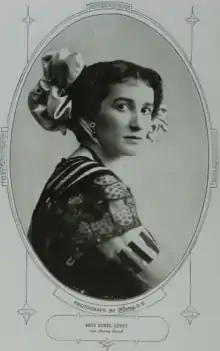Ethel Levey
Ethel Levey (November 22, 1880 – February 27, 1955), born Grace Ethelia Fowler,[1] was an American actress, dancer, and singer in musical theatre and on the vaudeville stage. She was the first wife of George M. Cohan, and the second wife of aviator Claude Grahame-White.
Ethel Levey | |
|---|---|
 Portrait of Levey by Sarony, published in 1910 | |
| Born | Grace Ethelia Fowler November 22, 1880 San Francisco, California |
| Died | February 27, 1955 (aged 74) |
| Nationality | American |
| Occupation | Actor |
| Spouse(s) | |
| Children | 1 |
Early life
Levey was born in San Francisco, California. Her stepfather was named Levy; she used another spelling of his surname as her professional name.[1]
Career
.jpg.webp)
Levey made her professional debut in San Francisco, in Charles H. Hoyt's A Milk White Flag in 1897. She appeared regularly on vaudeville programs in New York and on tour. After marrying George M. Cohan, she continued performing with him, in The Governor's Son (1901 and 1906), Running for Office (1903), Little Johnny Jones (1904), and George Washington Jr. (1906).[2] After their divorce, her Broadway appearances included roles in Nearly a Hero (1908),[3] Watch Your Step (1914), Go Easy, Mabel (1922), Sunny River (1941), and Marinka (1945). She was also seen in London, in the revues Hullo Ragtime (1912), Hullo Tango (1913), Look Who's Here! (1916),[4] Follow the Crowd (1916), Three Cheers (1917), Oh! Julie (1920), and Blue Kitten (1925).[1][5][6]
Irving Berlin recalled Levey's slower interpretation of his "Alexander's Ragtime Band": "I remember how upset I was at her rendition of it. The audience, of course, did not agree with me. She was a riot."[7]
She appeared in the film High Stakes (1931) and in a 1940 short comedy, "Tattle Television".
Personal life
.jpg.webp)
Levey married George M. Cohan in 1899, in Atlantic City, New Jersey.[8] They had a daughter, Georgette (1900–1988),[9] before they separated in 1906 and divorced in 1907.[10] She was rumored to be engaged to actor Robert Edeson in 1907.[11][12] There was another rumor that Levey had married a French equestrian, Pierre Crespina, in 1910.[13] Levey and her daughter lived in Paris before World War I.[14] Levey married again, to English aviator Claude Grahame-White, in London in 1916.[15][16] With Grahame-White, she flew over wartime France and regularly commuted by air between Paris and London.[17] Grahame-White disliked her continuing stage career;[18] the couple divorced in 1939.[19][20]
In 1942 she unsuccessfully sued Warner Brothers for invasion of privacy over Yankee Doodle Dandy, a film biography of George M. Cohan. (His domestic life is highly fictionalized in the film.)[21]
Levey died in 1955, aged 74, in New York City.[22]
References
- Cullen, Frank, Florence Hackman and Donald McNeilly (eds.) "Ethel Levey", Vaudeville Old & New: An Encyclopedia of Variety Performances in America, Psychology Press (2004), pp. 679–680. ISBN 9780415938532
- "Ethel Levey", AllMusic.
- "Scenes in Sam Bernard's New Piece, 'Nearly a Hero'", Theatre Magazine (April 1908), p. 91
- "Our Captious Critic", The Illustrated Sporting and Dramatic News (August 5, 1916), p. 646.
- Slide, Anthony. The Encyclopedia of Vaudeville (University Press of Mississippi 2012): 311-312. ISBN 9781617032509
- Hischak, Thomas. The Oxford Companion to the American Musical (Oxford University Press 2008). ISBN 9780199891474
- Hamm, Charles. Irving Berlin: Songs from the Melting Pot: The Formative Years, 1907-1914 (Oxford University Press 1997), p. 136. ISBN 9780195361148
- "Cohans have Separated" Boston Globe (December 28, 1906): 1. via Newspapers.com

- Georgette Cohan photographs and memorabilia, 1895–1978, New York Public Library, Archives & Manuscripts.
- "Ethel Levey Isn't Earning Any Money Now", Wichita Beacon (October 11, 1913), p. 11. via Newspapers.com

- "Ethel Levey Injured" Washington Post (August 25, 1907), p. 3. via Newspapers.com

- "'Strongheart' to Wed Ethel Levey", Daily Arkansas Gazette (March 4, 1907), p. 4. via Newspapers.com

- "Ethel Levey Married Abroad", The New York Times (July 8, 1910), p. 7. via Newspapers.com

- "American Best Dressed Says Miss Ethel Levey", Brooklyn Daily Eagle (July 18, 1911), p. 18. via Newspapers.com

- "Ethel Levey Bright of Grahame-White", Boston Globe (December 22, 1916), p. 9. via Newspapers.com

- "When You're Divorced Your Troubles Begin" The Times (December 11, 1921), p. 51. via Newspapers.com

- "About Ethel Levey", Brooklyn Daily Eagle (March 8, 1921), p. 8. via Newspapers.com

- "Grahame-White Detests Stage", Boston Post (March 30, 1921), p. 2. via Newspapers.com

- "Ethel Levey to File Petition for Divorce", The New York Times (December 3, 1937), p. 29.
- "Gay 90's Girl Divorced", Daily News (March 31, 1939), p. 570. via Newspapers.com

- John T. Aquino, Truth and Lives on Film: The Legal Problems of Depicting Real Persons and Events in a Fictional Medium (McFarland 2005), p. 31. ISBN 9780786420445
- "Ethel Levey Dies of Heart Attack; Funeral is Tuesday", The Town Talk (February 26, 1955), p. 18. via Newspapers.com

External links
| Wikimedia Commons has media related to Ethel Levey. |